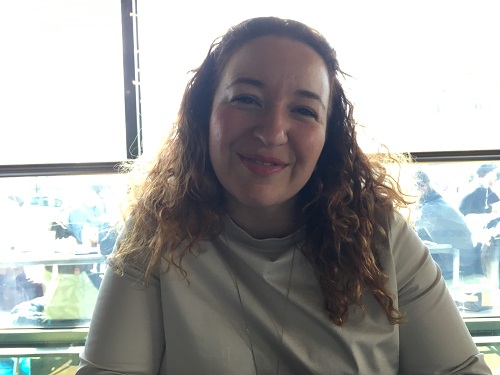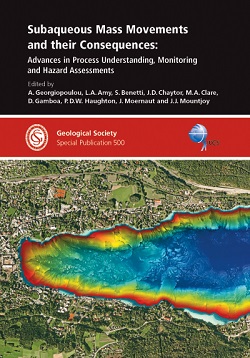A chat with the editor of the Geological Society’s 500th Special Publication
Pullen, L and Phillips, B., Understanding underwater landslides. Geoscientist 30 (9), 16-19, 2020
https://doi.org/doi: 10.1144/geosci2020-111, Download the pdf here
 This year, the Geological Society’s Publishing House published the 500th volume in its Special Publication series, which first appeared in 1964. SP500: Subaqueous Mass Movements and their Consequences’ looks at the latest research in underwater landslides and associated hazards.
This year, the Geological Society’s Publishing House published the 500th volume in its Special Publication series, which first appeared in 1964. SP500: Subaqueous Mass Movements and their Consequences’ looks at the latest research in underwater landslides and associated hazards.
The book’s Co-ordinating Editor, Dr Aggeliki Georgiopoulou, is a Senior Lecturer at the University of Brighton and a member of the Applied Geosciences and the Past Human and Environment Dynamics Research and Enterprise Groups, and the Centre for Aquatic Environments. She spoke to Lucy Pullen at the Society’s Publishing House about her research, and the marine geoscience community.
What can we expect to find in SP500?
The papers in this book present the latest results in underwater landslide research. It covers almost the entire world and includes diverse geological settings, from lakes and fjords to volcanic islands, passive and active margins.
Traditionally our research has been descriptive and observation-based, but it is becoming more and more numerical and follows technological advances and this can be seen in many of the contributions in this volume. Quite promising for the field is that much of the research included here is by early career researchers, who will be leading the way in the coming years.
What are some of the most exciting findings?
Submarine mass movements are very complex and there is still a lot to know about their dynamics and impact. Forecasting these events is very difficult, almost impossible, but the research here brings us several steps closer to characterizing the hazard that exists for certain areas.
Some of the most exciting results came from the 4D analysis work, where we can have a real dynamic feel of movement throughout the years and decades. This can only be possible through repeat surveys of specific areas and the implementation of monitoring systems for continuous record, which is probably where a lot of the future effort of marine research will focus. This is extremely important for tsunami hazards, of which we have seen quite a bit in the last decade or two.
The book contains one of our most downloaded Special Publication papers so far this year (‘Indonesian Throughflow as a preconditioning mechanism for submarine landslides in the Makassar Strait’ by Brackenridge et al.) Why do you think this paper is especially appealing?
One of the reasons is probably the proximity of the study area to the Bay of Palu, which was struck by the Palu-Sulawesi tsunami in 2018. The media picked up on the paper because of this and almost certainly exposed it to a wider audience. There was a considerable death toll from the combined effect of the earthquake and tsunami, in addition to all the material damage.
Sadly, it is often when we, as a global population, suffer the consequences of such natural disasters that attention is paid to their historical occurrence. Brackenridge et al.’s paper is very valuable as it provides a scope of the size of the massive submarine landslides with tsunamigenic potential that occurred within the Strait of Makassar, all of them much larger than the Palu one in 2018. If a tsunami is generated by such massive failures, the impact on the surrounding coastal areas would be truly devastating, so we and local authorities and governments need to be aware of the risks.
One of the focuses of this volume is the societal impacts of subaqueous landslides and risks for inhabited areas. Why are these issues particularly relevant right now?
It becomes more relevant when people see these events and their aftermaths during their lifetime. It is the ‘out of sight, out of mind’ effect, and nowhere is this more relevant than for processes that take place beneath the ocean or lake surface. It is not that this kind of work was not being done before – for instance, there was the recent Anak Krakatau collapse and resulting tsunami on 22 December 2018. A 2012 piece of work by Giachetti et al., published in another Geological Society Special Publication (Volume 361, Natural Hazards in the Asia–Pacific Region: Recent Advances and Emerging Concepts) had modelled such an event and their tsunami model was similar to what actually happened. However, at the time of its publication, the paper did not get the attention it probably should have.
The recent events are a reminder that geohazards are all around us and can occur any time now; they are not just catastrophic events in history books. Policy-makers and insurance companies are also more aware of the importance of research into geohazards, again as a result of seeing things happening, and subaqueous landslides and tsunami hazards are increasingly accounted for in civil protection plans.
The next challenge is to keep these hazards in the minds of the general public and policy-makers. The increasing efforts given to science, technology, engineering and mathematics (STEM) and related activities are crucial for this, so as scientists, apart from carrying out the actual research, we must also focus on outreach to create awareness about the impact of geohazards.
What are the most important unanswered questions in this field?
There are many … one of the first challenges we encounter is to compare across scales. We can study subaqueous landslides exposed on outcrops, on seafloor bathymetry and direct sampling, on ultra-high resolution seismic or on ‘standard’ seismic data buried several hundred to thousands of metres beneath the seafloor or lake floor … all these different scales of analysis provide different data that are often challenging to integrate.
One question that comes to mind relates to the recurrence of events. How long is the gap between events and what controls the events and therefore the recurrence interval? This gets very challenging the older and the larger these events are, as they often end up being complexes with various amalgamated or fused deposits. Understanding their dynamics is also a challenge as what we tend to see are ‘still frame shots’ of the final result, the deposit, which is the ‘dying’ stage of an underwater landslide, not its most dynamic. For some we can infer, with some degree of uncertainty, that they were slow-moving, others fast-moving and others a mix of evolving processes, transitioning from one to another, that we may not be able to resolve entirely. This leads to something I mentioned earlier, and where I see a part of the future of this research: 4D evolution through continuous monitoring. This may provide a lot of new data and perspectives on the study of these events.
What’s it like being a part of this community?
 Our community is very collaborative, very friendly, very passionate about science and landslides, inclusive and helpful. You will see that many of the papers we produce are multi-authored, which reflects not only the requirement our science has for collaboration but also that spirit of collegiality.
Our community is very collaborative, very friendly, very passionate about science and landslides, inclusive and helpful. You will see that many of the papers we produce are multi-authored, which reflects not only the requirement our science has for collaboration but also that spirit of collegiality.
Our biannual dedicated conference (International Symposium on Subaqueous Mass Movements and Their Consequences), such as the one that led to this Special Publication (although the conference has been postponed to 2021 because of the pandemic), is actually a meeting of old friends catching up on work and life, and a platform for new people to join us. As a result of these frequent and friendly interactions SLATE (Submarine landslides and Their impact on European continental margins) was created, a major European Training Network funded by the EU to train the next generation of subaqueous landslide experts through integrated innovative research.
What are your thoughts on being the 500th Special Publication?
We are really excited about that! Creating the 500th volume is a very proud moment for me and the team. Beyond the valuable landmark of such a round number, it will also make our volume number easy to remember!
Further reading:
SP500: Subaqueous Mass Movements and their Consequences: Advances in Process Understanding, Monitoring and Hazard Assessments, edited by: A. Georgiopoulou, L. A. Amy, S. Benetti, J. D. Chaytor, M. A. Clare, D. Gamboa, P. D. W. Haughton, J. Moernaut and J. J. Mountjoy